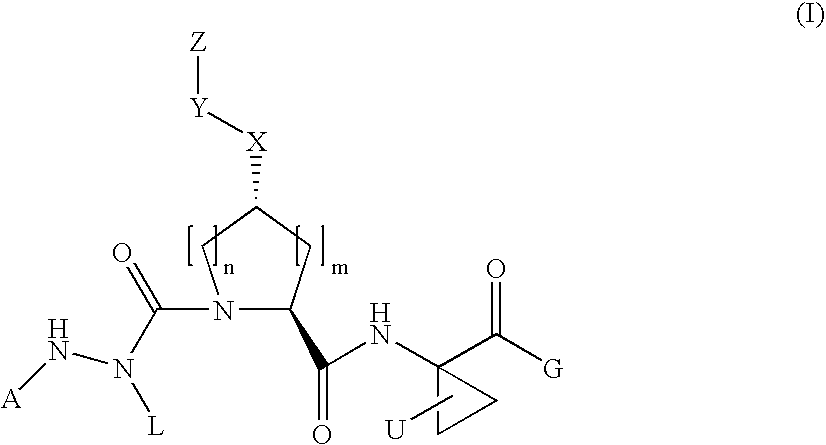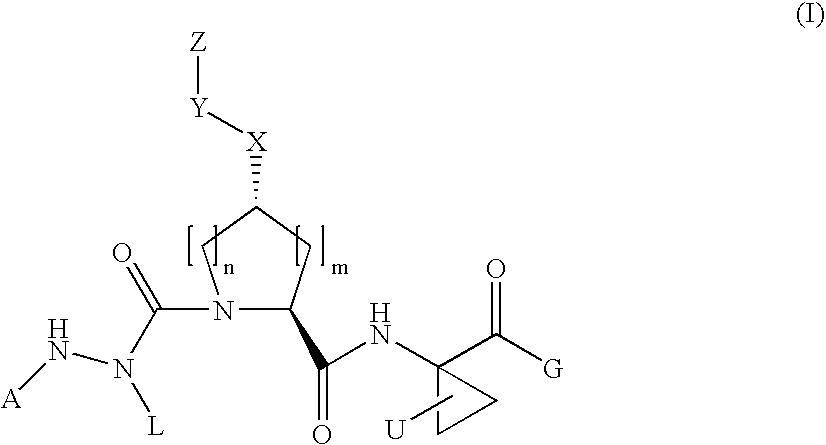Aza-tripeptide hepatitis c serine protease inhibitors
a technology of azatripeptide and serine protease, applied in the field of new drugs, can solve the problems of interferon related side effects, inability to reproduce infectious culture systems and small-animal models for hcv, and increasing public health problems
- Summary
- Abstract
- Description
- Claims
- Application Information
AI Technical Summary
Benefits of technology
Problems solved by technology
Method used
Image
Examples
example 1
[0202]Synthesis of the Azatripeptide Precursor
[0203]1A. To a solution of commercially available Cis-Boc-hydroxyproline 1-1 (12.72 g, 55 mol) and amino acid ester 1-2 (10.54 g, 55 mol) in 65 ml DMF was added HATU (20.9 g, 55 mmol) and DIEA (28.7 ml, 165 mmol). The coupling was carried out at 0° C. over a period of 1 hour. The reaction mixture was diluted with 500 mL EtOAc, and directly washed with 1M NaHCO3 (4×100 ml) and brine (2×50 ml). The organic phase was dried over anhydrous Na2SO4, filtered, and then concentrated in vacuo, affording the dipeptide 1-3 that was identified by HPLC (Retention time=8.9 min, 30-70%, 90% B). MS (ESI): m / z=369.18 [M+H].[0204]1B. Dipeptide 1-3 from step 1B was dissolved in 140 mL of 4N HCl in dioxane. The reaction mixture was stirred at room temperature for 2 h until LCMS showed the complete consumption of starting material. The solvent was removed in vacuo to afford the intermediate 1-4, MS (ESI): m / z=269.22 [M+H].[0205]1C. Preparation of compound 1-5...
example 2
[0211]Compound of Formula VII, wherein
[0212]Step 2A. To a cooled mixture of the title compound from step 1A (1-3), 3-(thiophen-2-yl)-1H-quinoxalin-2-one (1.1 equiv.), and triphenylphosphine (1.5 equiv.) in THF was added DIAD (1.5 equiv.) dropwise at 0° C. The resulting mixture was held at 0° C. for 15 min. before being warmed to room temperature. After 10 hours, the mixture was concentrated under vacuum and the residue was purified by chromatography eluting with 60% EtOAc in hexanes to give E-2-1 (86%).
[0213]MS (ESI): m / z=579.17 [M+H].
[0214]Step 2B. Compound E-2-1 from Step 2A (80 mg, 0.14 mmol) was treated with HCl (4 M in dioxane, 2 mL, 8.0 mmol). The reaction mixture was stirred at room temperature for 1 h until LCMS showed the complete consumption of starting material. The solvent was removed in vacuo. The residue was dissolved in DCM (3 ml). The solvent was removed in vacuo to provide crude compound E-2-2, which was used directly in next step.
[0215]MS (ESI) m / z=479.14 (M+H)+.
[0...
example 3
[0220]Compound of Formula VII, wherein
[0221]Step 3A: Cyclopropylsulfonyl chloride (1.4 g, 10 mmol) was dissolved in 0.5 M ammonia in dioxane (50 ml, 25 mmol) at RT. The reaction was kept at RT for 3 days. The large amount of precipitation was filtered and discarded. The clear filtrate was evaporated in vacuo and the white residue was dried on vacuum for 24 hours to give the cyclopropylsulfonamide (0.88 g, 74%). 1H-NMR (500 MHz, CD3Cl): δ 4.62 (2H, s), 2.59 (1H, m), 1.20 (2H, m), 1.02 (2H, m).
[0222]Step 3B: The title compound from Example 2 (15.0 mg, 0.023 mmol) and carbonyldiimidazole (6.0 mg, 0.034 mmol) were dissolved in 1.0 ml anhydrous DMF and the resulting solution was heated to 40° C. for 1 hour. Cyclopropylsulfonamide (8.0 mg, 0.06 mmol) was added to the reaction followed by DBU (4.0 mg, 0.023 mmol). The reaction mixture was stirred at 40° C. for 10 hour. LCMS showed the formation of the desired product. The reaction was cooled down and 10 ml ethyl acetate was added to the so...
PUM
| Property | Measurement | Unit |
|---|---|---|
| temperature | aaaaa | aaaaa |
| emission wavelength | aaaaa | aaaaa |
| excitation wavelength | aaaaa | aaaaa |
Abstract
Description
Claims
Application Information
 Login to View More
Login to View More - R&D
- Intellectual Property
- Life Sciences
- Materials
- Tech Scout
- Unparalleled Data Quality
- Higher Quality Content
- 60% Fewer Hallucinations
Browse by: Latest US Patents, China's latest patents, Technical Efficacy Thesaurus, Application Domain, Technology Topic, Popular Technical Reports.
© 2025 PatSnap. All rights reserved.Legal|Privacy policy|Modern Slavery Act Transparency Statement|Sitemap|About US| Contact US: help@patsnap.com



